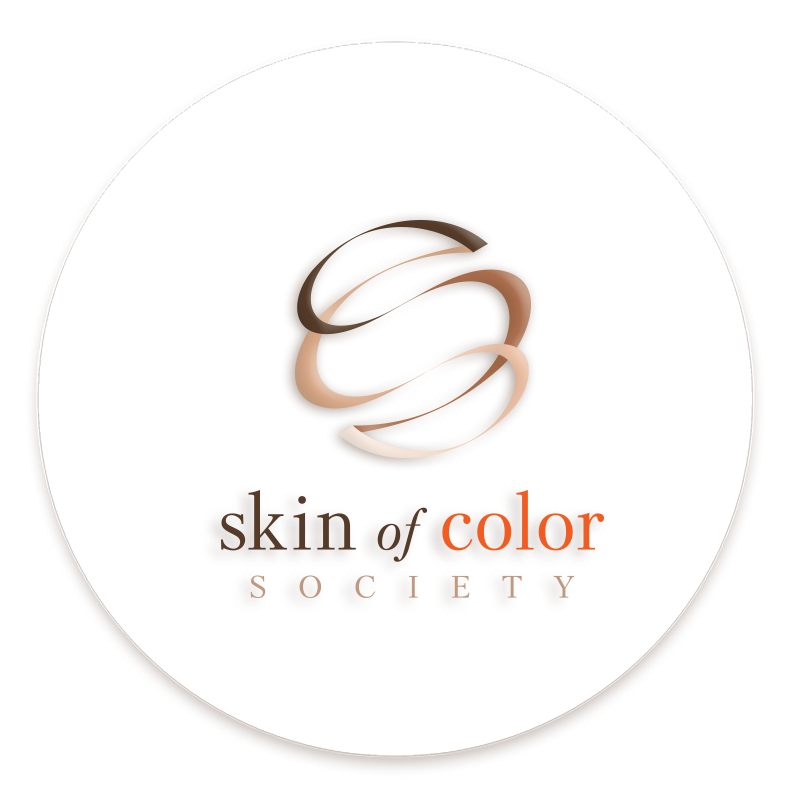Acne in Skin of Color
Chere Lucas, MD
Acne is a common skin problem. Otherwise known as “breakouts” “pimples”, “zits”, or “blemishes”, this condition can happen at any age. Usually starting when people are in their early teens, acne can continue into a person’s 30s or 40s and even beyond. In some individuals, acne can start later in life even if a person never had acne as a teenager. Acne can occur on the face, chest, shoulders and back. It can be very mild with only a few whiteheads/blackheads and areas of either brown or pink staining, or severe with painful cysts (larger bumps under the skin) and scarring. Acne can be frustrating, but it is treatable.
For skin of color patients who develop acne, the secondary skin color changes can be of primary importance. Specifically, dark spots from acne, referred to as post-inflammatory hyperpigmentation (PIH), is often a chief complaint.
Different types of Acne
Mild: A few comedones (blackheads or whiteheads) with little inflammation (redness, irritation, pain)
Moderate: More comedones or even pustules (pus filled bumps), inflammation few papules (small red or brown bumps)
Severe: a combination of comedones, papules and cysts. It often has significant inflammation, pain and even scarring. Because this type of acne leads to scarring that is challenging to improve, early treatment is important.
What causes acne?
Acne is caused by a combination of factors: clogged pores, increased oil production, inflammation (redness and irritation) and bacteria called Cutibacterium acnes (C. acnes). Skin pores become clogged and oil builds up in the pore or hair follicle. A pore clogged with oil is called a comedone. Whiteheads are closed comedones deeper in the skin. Blackheads are open comedones near the surface of the skin. They appear dark because the oil (sebum) and skin cells filling the pore become dry. It is important to know that they are not dark because of dirt. A comedone can become inflamed when e bacteria (including C. acnes) on the surface of skin gets into the pore. This causes red bumps under the skin. These can be painful and tend to last longer.
What Makes Acne Worse?
- Squeezing, scrubbing or picking at the skin
Over-exfoliating
•Irritants from the environment (i.e. pollution)
•Greasy products such as certain skin or hair products il
•Make-up and makeup brushes that aren’t clean
•Hormones–acne often worsens during puberty and may be related to women’s menstrual cycles
•Things that put pressure on your skin: sports wear, helmets, cell phones
•Grease in workplace (i.e. kitchen with fryers)
Does All Acne Scar?
No. You can have marks left by acne that are not permanent. The pink, purple and brown stains left from acne may take many months to years to fade but are usually not permanent. However, ome types of acne such as severe cystic acne can lead to permanent scars so it is important to get it treated early.
Treatment Options:
The goal of treating acne is to clear existing lesions and prevent new breakouts. Acne treatments target the causes of acne. This can take some time so it is important to be patient. There are many different treatments depending on what type of acne you have, what you have used in the past, and the amount of post inflammatory hyperpigmentation or scarring present. Some things that may have worked for your friends or family may not be the right choice for your skin type. Your doctor will work with you to develop a treatment plan. Once your acne is improved or clear, stick with the plan. It may be necessary to continue treatment to keep your skin clear long term.
Commonly used types of medications include:
Antibiotics
Antibiotics are used to clear bacteria from the skin and reduce inflammation. These can be applied to the top of the skin or taken by mouth. Examples of topical antibiotics include benzoyl peroxide, clindamycin, and erythromycin. Oral antibiotics may include tetracycline, minocycline or doxycycline. If you have an allergy to these, your doctor may choose something else.
Retinoids
Retinoids are a type of vitamin A. They help to exfoliate the skin and unclog pores, which is great for treating and preventing new comedones. Examples include tretinoin, tazarotene or adapalene. Retinoids in a pill form (isotretinoin) can help with severe acne.
Hormonal Agents
Hormones such as androgens play a role in acne. Androgens promote oil production in pores that contribute to clogged pores. Oral contraceptive pills and spironolactone are common oral hormonal agents that reduce androgen activity and can be effective treatments in select females. Topical clascoterone can be used in males and females and is a topical anti-androgen that can be helpful for acne.
SKIN CARE AND PREVENTION TIPS:
Gentle skin care
If a product stings too much or makes your skin dry it can worsen acne. Using things like rubbing alcohol to dry the skin can make acne worse.
No picking!
Squeezing, popping or picking at the skin can make acne last longer. It can also drive the clogged pores and bacteria deeper into the skin, causing large cysts that scar. Picking may contribute to scarring and post-inflammatory hyperpigmentation.
Skin care products
Be careful choosing products for your skin and hair. Use oil-free, non-comedogenic products. It should say this on the label. Hair products with silicone or dimethicone are less likely to block pores than oils.
Sun protection is important
Even if you have darker skin, the sun can make the dark spots last longer. Limit sun exposure and use daily non-comedogenic sunscreen to help acne pigmentation clear faster.
Be Patient!
It can take at least 6-8 weeks for acne to respond to treatment. Skin needs time to heal and change. If treatment is stopped early, you may not see results and the acne will return. Sometimes skin will look worse before it gets better as clogged pores are getting cleared out of the skin. Often, more than one medication is required. So stick with the plan and contact your dermatologist’s office if you have any concerns.
Additional Resources





